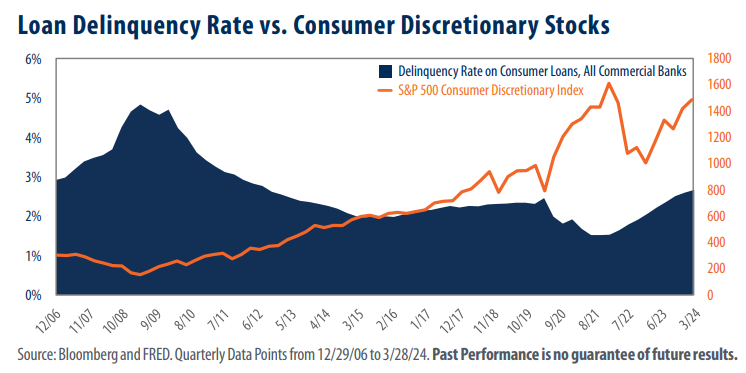
View from the Observation Deck
For today’s post, we compare the delinquency rate on consumer loans issued by all U.S. commercial banks to the prices of the S&P 500 Consumer Discretionary Index, over time. We use data from the Board of Governors of the Federal Reserve System, retrieved from FRED, for the former set of observations.
At 42.30%, the S&P 500 Consumer Discretionary Index (Consumer Discretionary Index) boasted the third-highest total return of the 11 major sectors that comprise the S&P 500 Index in 2023. The Consumer Discretionary Index has not fared as well in 2024, posting a year-to-date (YTD) total return of 4.10% thru 6/25/24. With a total return of -3.93%, Real Estate is the only sector in the S&P 500 Index with a lower total return than consumer discretionary stocks YTD through 6/25/24.
spending appears to be weakening, which has had an impact on U.S. GDP. Data from the Federal Reserve Bank of St. Louis reveals that consumer spending (as measured by Personal Consumption Expenditures) has comprised 67.7% of U.S. GDP, on average, since the end of 2006. Notably, real GDP growth was revised downward from 1.6% to a tepid 1.3% in Q1’24, led by a decline in personal consumption and slower growth in inventories. Core sales, which are crucial for estimating GDP, were up just 0.1% on an annualized rate through the first five months of 2024 while sales at restaurants and bars were down 2.3% on an annualized rate over the same period, according to Brian Wesbury, Chief Economist at First Trust Portfolios, LP.
As revealed in today’s chart, after falling to an all-time low of 1.53% in Q3’21, the consumer loan delinquency rate surged to 2.68% at the end of Q1’24. Loan delinquency rates among credit cards and auto loans have risen as well.
One important aspect of overall consumer health is the rate at which they are defaulting on their debt obligations. To be sure, not all delinquencies will become defaults, but a spike in the number of payments that are past-due could be an indication that the U.S. consumer is under increasing financial duress. The loan delinquency rate for credit cards issued by all insured commercial banks stood at 3.16% at the end of Q1’24, its highest level since the close of Q4’11. In addition, S&P Global reported that the percentage of U.S. auto loan delinquencies rose to 3.32% in 2023, marking the highest level for the metric since at least 2013.
Takeaway
The delinquency rate on consumer loans issued by all U.S. commercial banks, stood at 2.68% at the end of Q1’24. At current readings, delinquency rates are well below their historical average of 3.07% and even further below their all-time high of 4.85%. That said, the recent surge in delinquencies is notable and does appear to be a trend. Given their sizeable contribution to GDP, we maintain that a healthy U.S. consumer may play an integral role in the U.S. avoiding an economic recession. We will continue to monitor the delinquency rate among consumers and report on changes.



